Estimated reading time 15 minutes, 54 seconds.
Practice, as they say, makes perfect. In our world, nothing proves the adage more than airshows — a colorful circus where the big-top is vast, three-dimensional, and arguably dangerous.
Mark your calendars and hope for blue skies when Canada’s 431 Air Demonstration Squadron, better known as the Canadian Forces Snowbirds, begins this year’s airshow program with 23 stops across Canada and the U.S., including six “non-aerobatic” events.
The Snowbirds’ 2023 schedule will see them visit all 10 provinces in Canada from June to September, with their first event at home set for June 3 to 4 in Thunder Bay, Ontario. The team’s last show is to be held in Salinas, California, in October, before they will fly home to Canadian Forces Base Moose Jaw in southern Saskatchewan. During the season, they will log hundreds of hours and thousands of kilometers.

As with any circus, there’s much more to the Snowbirds than the 11 pilots and fleet of single-engine CT-114 Tutors, which were the RCAF’s primary jet trainer from the early 1960s until 2000. An 18-member support crew, headed by Sgt Simon Fredette, ensures that the jets remain in tip-top shape for their big-top performances.
Every spring, before the airshow season begins, the team of pilots and supporting crew sets up for several weeks at 19 Wing Comox on Vancouver Island to begin training. This year, the Snowbirds trained from April 18 to May 12, flying six days a week — usually twice a day — leaving Sundays as downtime for maintenance.
In mid-May, Skies met up with Snowbird team lead, Maj Brett Parker, after a final practice in Comox before the team returned home to Moose Jaw.
He said “part of the charm” with the Snowbirds is the team’s ability to change show elements frequently. That’s unlike the U.S. Navy Blue Angels, which fly F/A-18 Super Hornets, and the U.S. Air Force Thunderbirds, which fly F-16 Fighting Falcons. Their shows are reported to be tightly-scripted.
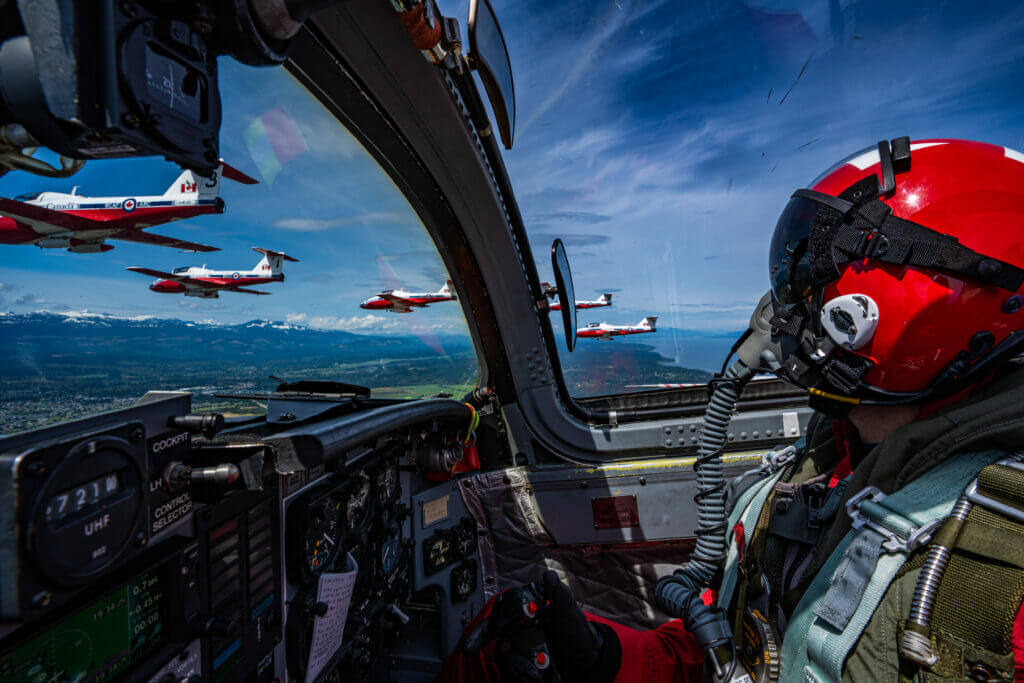
“There’s nothing wrong with that,” said Parker, noting that the U.S. teams are targeting a younger generation of potential recruits with revamped programs — which they unveiled at the International Council of Air Shows convention in Las Vegas last December.
“We have about 150 formations in our playbook, and we can usually get through about 40 to 45 in an average show,” added Parker. So the program can be adjusted as the season progresses, which he said is “kind of cool” because team members have program input as opposed to a top-down approach.
Parker, who is from Edmonton, Alberta, is on his second tour with the Snowbirds, and has more than 5,000 hours in his career log in trainers and fighters. He first flew with the Snowbirds from 2010 to 2014, initially as Snowbird 5 (second in line astern in the team’s nine-aircraft diamond pattern) for two years before moving to No. 3 (inner left wing behind the team leader), and then to No. 2 (inner right wing). He returned in 2021 as Snowbird 7 (outer left wing) for a year before moving front and center with No. 1 on his rudder.
Like the rest of the team, Parker brings a wealth of experience to the Snowbirds. He joined the Canadian Armed Forces in 1999 and, earning his wings in 2003, was posted to Moose Jaw where he instructed on the CT-155 Hawk — the lead-in trainer to the RCAF’s frontline fighter, the CF-188 Hornet. Four years later, he went to 410 Tactical Fighter Operational Training Squadron at Cold Lake, Alberta, to learn to fly Hornets before being assigned to 409 Tactical Fighter Squadron for three years.
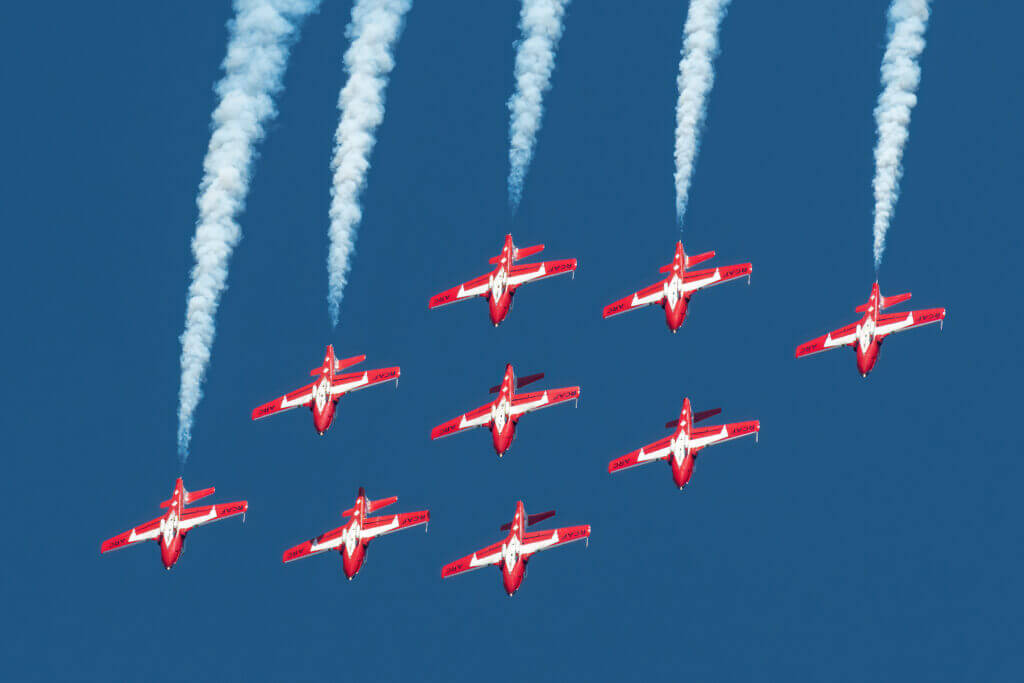
After his first Snowbirds tour, the RCAF posted him to RAF Valley in northwest Wales as an exchange pilot with the Royal Air Force, where he flew the latest T2 variants of the Hawk for three years. He then spent more time in CT-155s at 419 Tactical Fighter Training Squadron in Cold Lake before joining the Snowbirds for his current tour.
There’s no doubt that Snowbirds programs are spectacular. One element that stood out during the final Comox practice featured two Tutors maintaining low-level flight while two others spiralled around their colourful smoke trails as the formation streaked through the sky.
“We actually stole that, to a degree, from the Red Arrows [the Royal Air Force Aerobatic Team],” admitted Parker about the maneuver known as the “kaleidoscope.”
The Snowbirds debuted the kaleidoscope around 2011 at higher altitudes. Nowadays, it’s being flown as a low-altitude prelude to the team’s “heart” maneuver, which Parker described as a favorite.
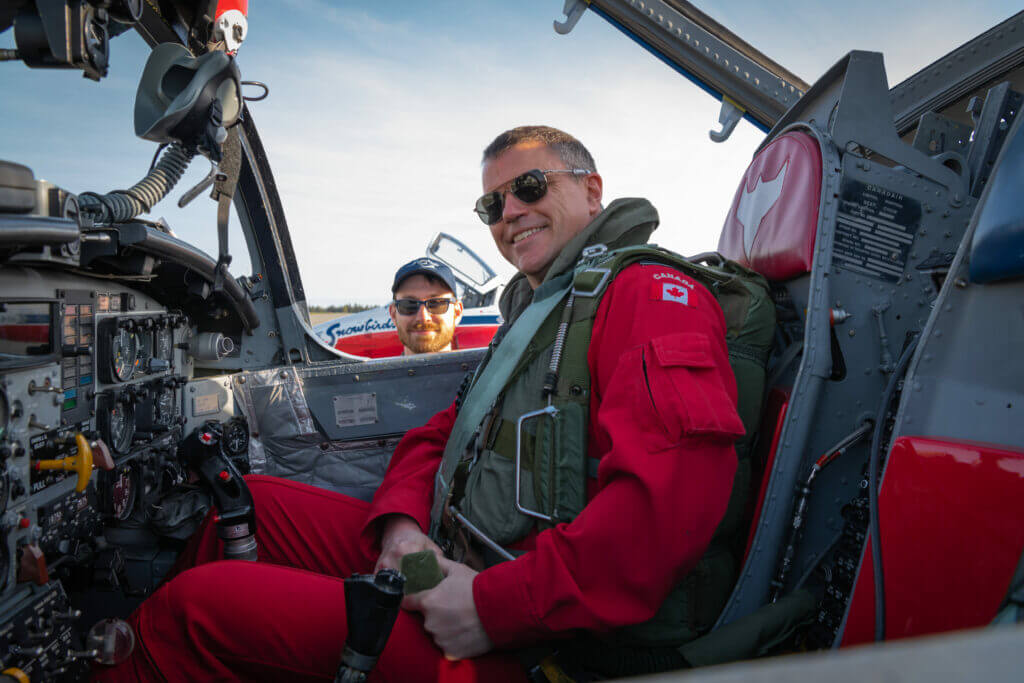
“It’s a great way to just connect with people,” he said.
The heart, though, requires a higher altitude to complete, so the kaleidoscope replaces that when shows are done at lower altitudes.
While airshows are seen mainly by crowds as entertainment, the RCAF sees them as a tool for recruiting people to the Canadian Armed Forces.
“I’m one of them,” Parker chuckled. “An airshow brat, I was never in Air Cadets — even though I had quite a few friends who were. I was around when Top Gun (the 1986 blockbuster movie) came out.”
That led to Parker becoming an “airshow brat” who sought pilots’ autographs and papered his room with “all the posters.” He recalled being at RCAF Station Namao (now CFB Edmonton) in 1989, waiting for the team lead, Maj Dan Dempsey, to get closer for an autograph.
“He was the hometown kid, from Edmonton, so there was a big throng waiting for him,” recalled Parker.
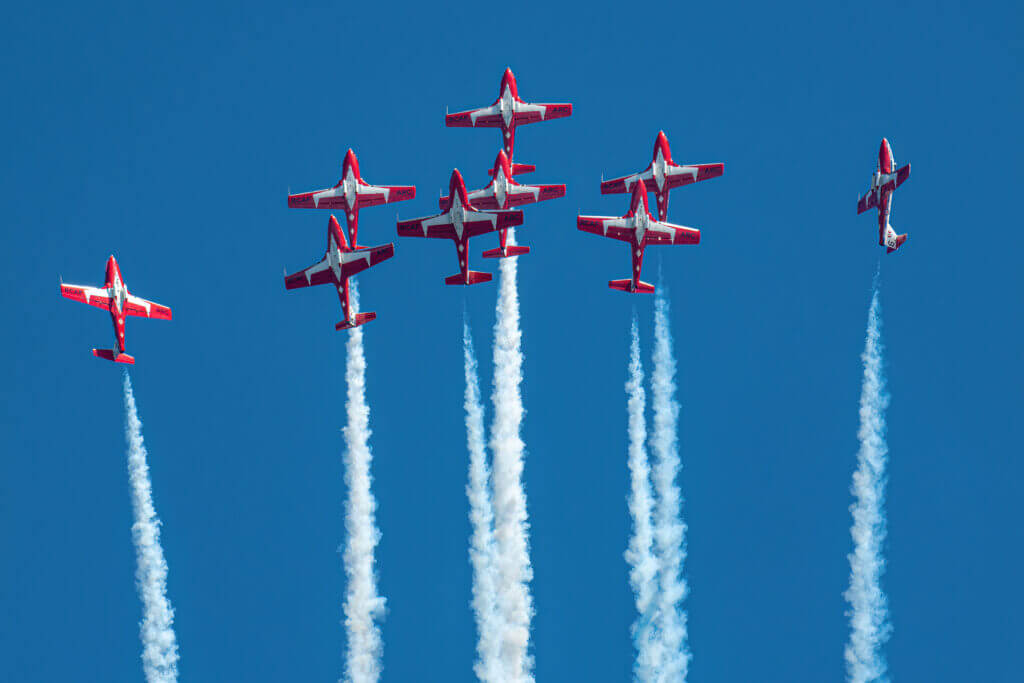
He said he waited for “the longest time,” chatting with Snowbird 2, Capt Shane Antaya, before he managed to collect signatures from Dempsey and the rest of the team.
“Thirty years later, I’m on the phone with Dan Dempsey himself, talking about some splits that they used to do in 1989 . . . that maybe I’d like to do in our show! That was pretty cool.”
A common question that pops up in RCAF circles, and elsewhere, is what could replace the Tutors? Is the Hawk a potential candidate?
“Probably,” Parker replied, “but the Tutor does this job incredibly well.”
Maneuvers are mostly at relatively low speed, 280 to 300 knots, even though the Tutor can top 400. Parker pointed out that the Hawk, an advanced trainer, is “quite a bit faster” — capable of Mach 1.15 in a dive. “So, could it do the job? Of course, but it would change the dynamics of the show; you’d have to take most sequences and decide whether that’s what you ultimately want to provide. But that’s the charm and grace of the Tutor; it’s been doing it phenomenally for the last 52 years.”
When it was suggested that the RCAF has a history of stretching the operational lives of its assets, Parker didn’t disagree. “Well, that’s the RCAF way,” he said.
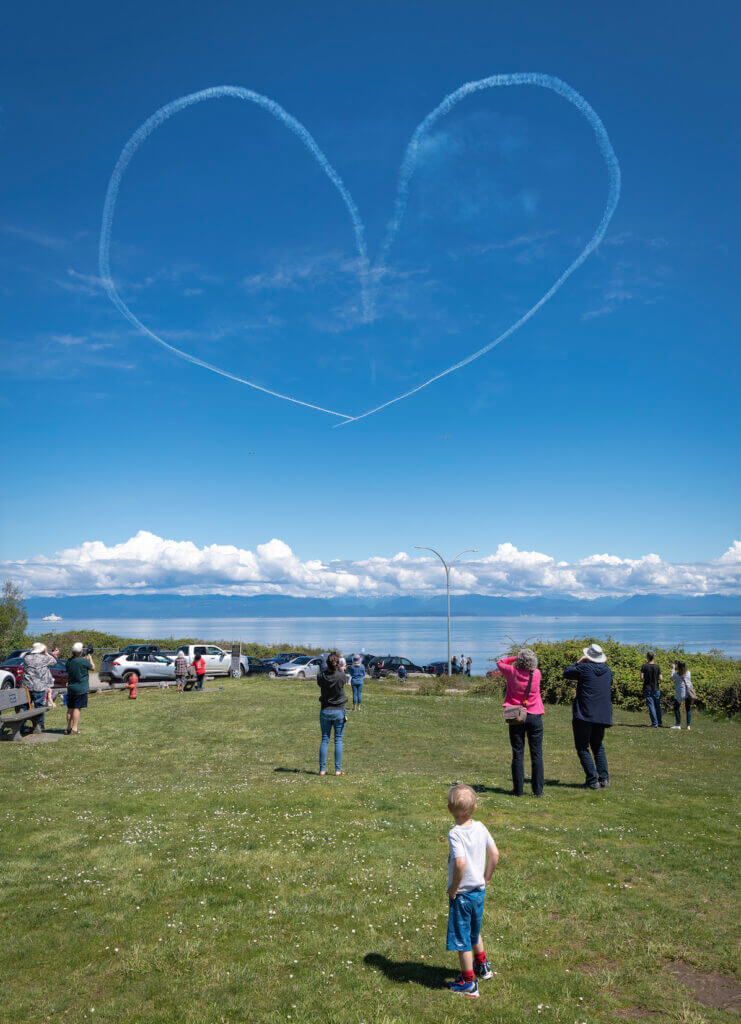
“There are a finite number of things on a Tutor that are no longer manufactured, so we either have our own shop build them or we have to find something else,” he added.
That said, the Tutor, which has modern avionics but control surfaces connected by rods and pulleys, “is still a lot of fun to fly.”
(Currently, the Tutors are undergoing a life extension project that will see the installation of ADS-B and upgraded avionics — allowing the aircraft to continue performing until 2030.)
Parker said deciding how long a pilot can stay a Snowbird is a bit of a juggling act. “It’s usually decided well before the season starts. We have to have a plan in place for successors, asking ourselves who’s on the team now, [and] how many years have they done?”
The time commitment to the team has changed. Historically, it used to be a two-year gig for pilots who effectively were on loan from training or tactical squadrons. The first year, they would be a junior team member trying not to fall behind. Then, in the second year before they rotated out, they’d be the senior pilot training newcomers.

“It’s quite a dial back today from what it used to be, but it all adds to the experience level,” said Parker. “We’re the only one flying the Tutor, so obviously you become knowledgeable about it. Back in the day, it didn’t matter whether you eventually flew multi-engines or helicopters, you first got your wings on the Tutor. Now, it’s a rare beast to pretty much everybody coming into the team.”
Curiously, there’s no current waiting list to become a Snowbird, which may not appeal to pilots who prefer other platforms. “You have to want to be on the team,” said Parker. “Airshows may not be for everybody, even though we get treated really well wherever we go.”
He reluctantly admitted that the Snowbirds often are treated “like rock stars” during the show season. “I tell the guys, ‘This is the gravy of the job, the interaction with the public.’”
Parker expects his second ride on this particular gravy train to end in October when the 2023 season ends and he rotates back to Cold Lake. As a major “nearing 50,” his RCAF career track likely means a command role in his future. But “if I can get my hands on a Hornet, I’ll take it,” he said.
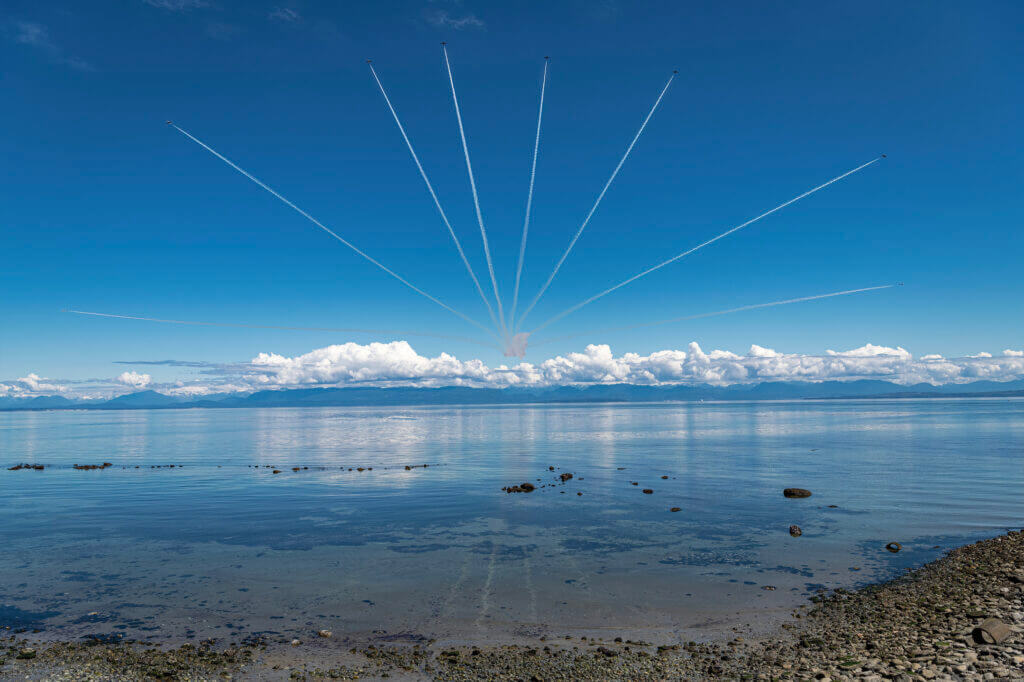
See the Snowbirds’ 2023 schedule here.









awesome to see